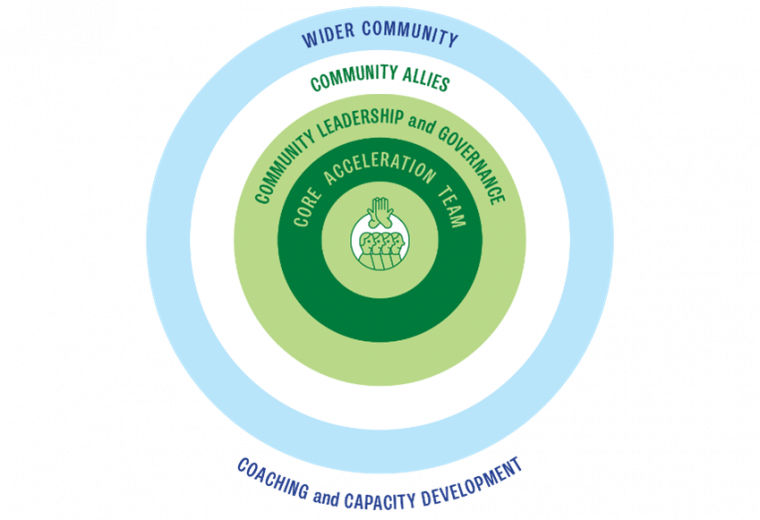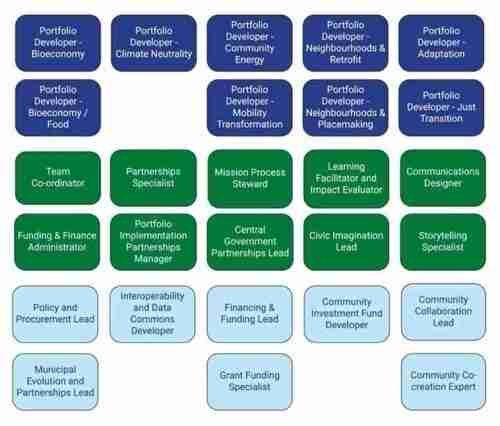Mission
Incubators
It is an enormous job to turn community missions into the broad and systemic changes that they demand.
A Mission Incubator model therefore needs to be established and empowered to be the ‘backbone’ of activating and incubating radical change towards a community’s missions.
This is core to organising, resourcing and managing radical enough processes of change. Especially because the job of leading such radical change is also one that usually falls beyond the current mandate or business model of any existing community organisations, including municipalities.
The purpose of Mission Incubator models is not to centralise and take over all the work needed to pursue missions. That is not possible or desirable. They should work more like hubs of a wheel, playing a central role in connecting different parts of the whole. They maintain the shape, without which the wheel would fail, but they are still only part of the whole. Many other actors in the community will have important roles to play, while the Mission Incubator team should help everyone to see and perform their roles more effectively as part of a strategic whole.
Our approach is that these Mission Incubator models should be made up of three layers, nested within the wider community:

- A core acceleration team comprised of the amazing people who are fully involved in leading and activating change processes day-to-day
- A suitable leadership and governance structure that is made up of committed community leaders. Their job is champion the mission process and to keep a safe space for the core team to function effectively.
- A network of community allies – people who can be called on as needed to help advance missions, either professionally or as volunteers.
An organisational model is needed to nest the Mission Incubator within the wider community, to align leadership and governance, and to formalise working roles of the core team. One option is to set up a new legal entity / social enterprise. In this case, governance and the team are ‘in-house’ and the new organisation will need partnership agreements with other actors in the community – to encourage collaboration and clarify expectations, resource sharing and delineation of efforts. An alternative is to form a distributed model bound together with partnership agreements and with the core team working for a ‘virtual’ organisation. There is no one-size-fits all answer, and communities need to carefully design a model that will work well for them, with a clear view to the fault-lines that can lead to failure of such models.
A Mission Incubator could potentially be organised to sit within a municipality structure, but in most cases we see that a more arms-length and independent organisation model works better. Leuven 2030 is a good example.
Mission Incubator models are eventually needed at multiple scales, from neighbourhood to national, and to cover overlapping mission topics. Therefore, it makes sense for different communities to work together to align the design of their Mission Incubator models in ways that maximise synergies and efficiency. We are therefore working on how national-scale Mission Incubators can help to accelerate change in SE Europe.
Activating radical change is not a job for a few overworked people.
It is essential to have a well-enough resourced core team. Conceptually an initial core Mission Incubator team might look something like this:

Investment in such a team should be seen as small when compared to the value of the wider investment and benefits that they are tasked with unlocking.
Nevertheless, many communities and funders still are still finding this an abstract business case to commit to. It is a hurdle that must be overcome and a viable funding model is needed to support the resourcing and work of this team over many years. This can be achieved in the short-term through a mix of partnerships, secondments, sponsorship and grant funding. Longer term communities can work towards a model where operating costs of the Mission Incubator are met as part of a larger Transformative Investment mechanism.
Many communities also find it challenging to recruit and retain the talented people they need on this team, which requires different skills and mindsets to many conventional jobs. Ongoing coaching and capacity development support is needed to help team members to be as effective as possible. Building the skills and experience of younger people to deploy their energy and enthusiasm into the team is also essential as they have the greatest stake in the future. Networked coaching and capacity development for mission-led change is a key part of the help that Mission Incubator teams can access as part of the Thriving Communities collective.
Mission Contracts are a valuable partnering tool that can help to bind actors together around community missions and Mission Incubator models
Mission Contracts are more likely to be Memoranda of Understanding than legally binding contracts. Either way, they should be written agreements that secure commitment from government, community actors and supporting organisations to delivering local missions and working with the Mission Incubator model. These contracts should be tailored to the local context and needs in each community.
A good example is the City Climate Contracts that have been developed through the Viable Cities programme in Sweden, and will be a priority as part of the next phase of the EU Climate Neutral Cities mission.
Local Green Deals are another example the EU is encouraging. Local Green Deal agreements are expected to be tangible action plans that bring the EU Green Deal down to a community scale and help to make sustainable change happen locally. They should clearly identify a vision/ambition, direction of travel and key actions that local stakeholders commit to leading/supporting.

